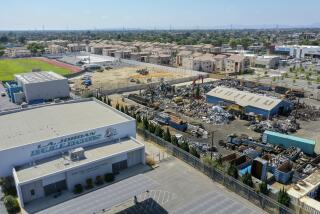Industry’s Mistakes Tough on School : Environment: Wilmington Park School is located in a heavily industrial area. When toxic fumes escape a plant, or refinery, students and staff suffer.
Friday was a pretty good day out at Wilmington Park School. The air was crisp and looked clear. The smells were slight. No one complained of headaches, nausea or stinging eyes.
Those days aren’t that common at the elementary school. In addition to their daily lessons, the 1,250 students receive an education in environmental hazards.
They have no choice.
The school is located in the industrial heartland near the Harbor City area of Los Angeles. Los Angeles Unified School District officials, who have been responding to complaints of toxic fumes in the area for more than a decade, have identified 80 industrial sites--including at least four major oil refineries--within a quarter of a mile of the school. And when one of the companies makes a mistake, the children and teachers at Wilmington Park sometimes pay.
That was the case Tuesday when more than a dozen teachers complained of a chemical odor around the school. Wilmington Park officials called the South Coast Air Quality Management District and did what they could to shelter the students and staff from the chlorine-like smell.
A subsequent investigation by AQMD uncovered an unlawful release of hazardous chemicals into the air at the school by one of the neighboring companies. Pacific Coast Fumigating Co. was cited for failing to comply with two conditions of its operating permit and faces up to $25,000 in fines for allegedly releasing methyl bromide, a colorless gas that is used as a fumigant.
For school officials and nearby residents, it was a rare case where the source of an illegal chemical emission was caught. They talk of the frustration of battling an unseen intruder on an almost-daily basis. And they hold little hope that it will ever get better.
“We have our good days when the air is clean and sweet smelling,” Wilmington Park Principal Nora Armenta said. “But then we have all those days when something ugly comes our way. And we’re usually left on our own to deal with it.”
Fumes from the surrounding sites are so ubiquitous that the only chance of tracking the source is when there is a large spill. With two sulfur plants, a refinery, a propane gas yard and other chemical-carrying companies within view of the school, only an obvious leak could be easily tracked, officials say.
The school, which was built in 1909, has coexisted with oil refineries for years. But the more recent mushrooming of other types of heavy industrial plants has made it more difficult to be neighbors.
It remains unclear how much risk the fumes pose to people in the area, but an AQMD study of the potential danger is expected to be released soon. Susie Wong, director of the school district’s environmental health and safety branch, said there were 20 complaints of chemical odors filed this year alone by officials at nearby Wilmington Junior High School.
“In this area, there are so many potential (hazardous material) sources that there is always going to be a lot of complaints,” she said. “The response to the problem (by AQMD) has been slow, but we have to realize that they won’t be able to change anything overnight.”
Wong said the school district will consider doing a computer model assessing the risks of schools in the area but that there is little the district can do to alter the environmental setting. She said the district is trying to get local authorities to improve plans for notifying schools about chemical releases.
Even AQMD officials concede that there is little that can be done to change the situation. They say the schools are simply outnumbered.
“In an industrialized area, you are going to have more problems like this develop,” AQMD spokesman Bill Kelly said. “We make an honest attempt to investigate the source but often the odors are intermittent and they’ve dissipated by the time we get an inspector there.
“We write quite a few notices of violation for odor complaints each year and we’re aware of the problem, but we can’t keep an inspector on each street corner.”
That is disheartening to long-time teachers such as Susan Diller, who says that even her desire to continue teaching may not be enough to get her to continue fighting a noxious enemy.
Diller, a teacher for 28 years, including more than a decade at Wilmington Park, said she is tired of fighting with government agencies to take action against companies that violate chemical emission laws.
“I think a lot of us feel that our complaints have been ignored,” said Diller, a learning disability specialist. “There are days when the teachers and students are lined up at the nurse’s office. There would probably be even more complaints, but you can’t send the whole school to the office.
“I love my job and I love teaching. But this problem is the only reason that I’d ever consider leaving. And the problem is not going to go away.”
More to Read
Sign up for Essential California
The most important California stories and recommendations in your inbox every morning.
You may occasionally receive promotional content from the Los Angeles Times.









